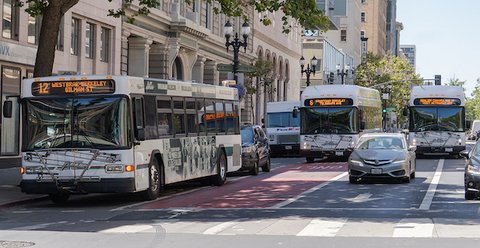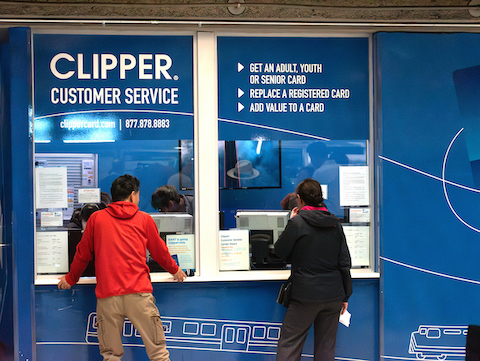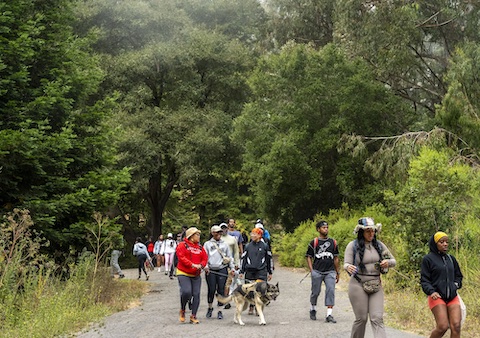
06 Aug New Regionwide Transit Pass Now Arriving After Pilot Programs Yield Positive Results

Clipper BayPass allows unlimited rides and transfers across all operators that use the Clipper card system for fare collection. (Metropolitan Transportation Commission via Bay City News)
By Andres Jimenez Larios
Bay City News
Following the success of initial trials of an unlimited Bay Area transit pass, universities and major employers are deciding whether they would like to join the BayPass program.
A collective effort organized by the Metropolitan Transportation Commission, the region’s transit planning agency, between all 27 public transportation providers across nine Bay Area counties and Cubic Transportation Systems, the company that oversees the technical operation of the Clipper card system, has resulted in the BayPass program that allows unlimited rides and transfers across all operators utilizing Clipper.
Phase one of the pilot program ran between August 2022 and the summer of 2024 with over 51,000 participants from San Francisco State University, San Jose State University, Santa Rosa Junior College, UC Berkeley, and 12 affordable housing properties from MidPen Housing.
Phase two has been rolling out since the start of this year wherein institutions work with the MTC to implement the BayPass program for their commuters through individualized contracts.
MTC spokesperson John Goodwin said the agency was thrilled to enact new beneficial changes for public transit that would hopefully make the experience more efficient, seamless, and inviting for riders across the region. He acknowledged the severe budget challenges many public transit agencies are facing and said BayPass was a small piece of the solution.
“We are selling BayPass to interested partners and are looking for more geographic diversity of participants around the Bay Area,” said Goodwin. “It is important to make transit more attractive and more competitive to driving. Make it faster and easier to use. Then more people might be interested to use transit, which is good in the long run.”
According to a final report by the MTC on the first phase of the program, students who were randomly assigned the free transit pass took more overall trips, used more transfers, and were less likely to leave school.
Low-income students with the pass increased their transit use by 27.4% compared to their counterparts without it during the first phase of the pilot.
Students at UC Berkeley voted overwhelmingly in spring 2025 to introduce a new semester transit fee for the majority of undergraduate and graduate students, starting in August. It includes a flat rate of $124 per student per semester for BayPass alongside an existing contract with Alameda-Contra Costa Transit District.
“We always advocate for increased alternative means of transportation to campus, and this program will help more students have more opportunities to commute to campus,” said UC Berkeley spokesman Kyle Gibson. “We have one of the lowest ridership rates already for cars, so this program only further helps decrease the amount of people commuting to campus by automobile.”
SFSU’s Gator Pass has been updated to include the BayPass program as of fall 2024. According to the MTC’s report, more than half of the students at the university commuted by transit, making it the most common way individuals arrived at campus.
“The expansion is a result of student feedback and advocacy from SFSU’s Associated Students, which surveyed students about expanding the Gator Pass,” said campus spokesman Kent Bravo in an email. “Now that it is an established program, BayPass will continue as long as the MTC can support it and the Student Fee Advisory Committee (SFAC) deems the program necessary.”
UCSF has also been expanding its program since Jan. 1, 2024. Students and some eligible employees have been regularly using the service.
“The BayPass pilot is popular among students because it expands their transportation options at a reduced cost,” said UCSF spokesman Tyler Dewey. “While UCSF provides shuttles between campus locations, the BayPass program provides an additional low-cost option to get around the city and the larger Bay Area.”
While three major schools decided to expand their collaboration with BayPass, SJSU was one of the phase one participants that did not elect to roll out the program to the entire student body.
Department manager of SJSU’s transportation solutions Haleema Bharoocha said the university sees the benefit of the BayPass program, but the lack of staffing in key department positions across the administration has stalled progress on implementing the program.
“Without having that leadership within the office and having these roles vacant is the main reason why we haven’t had any definitive next steps to BayPass phase two,” said Bharoocha.
She said it would take a minimum of one year for BayPass to go through the school’s studies and voting process, but she remains optimistic the program will be implemented in the future.
Sam Jeffs has been campaigning for BayPass to expand at SJSU. Jeffs hypothesizes that the school administration is hesitant to raise student fees, but believes the small increase in student fees would ultimately save the large commuter population thousands in the long-term.
“The Student Union is sold on it already. It actually has a good lasting effect. it’s good for students, and it’s an affordable rate for students,” said Jeffs. “We surveyed and we found, 61% of students who commute spend an astronomically large amount of money. To say that (SJSU officials) don’t want to increase the cost for students is kind of ironic because we are spending a lot of money to travel.”
Students are the not the only ones benefitting from the new transit pass. Major employers like San Francisco International Airport, OpenAI, and city governments are electing to use Clipper BayPass to move their employees.
Airports are connected by bus and rail lines, making facilities like SFO uniquely positioned to capitalize on a transit pass for their workers. According to the airport, it is paying a minimum of $1.33 million to participate in BayPass, while workers directly employed by the city of San Francisco can elect to participate and pay $5 a month for their transit pass.
“The BayPass Program directly advances SFO’s mission of ‘delivering an airport experience where people and our planet come first’ by prioritizing both employee well-being and environmental health,” said SFO spokesman Doug Yakel. “By encouraging employees to use transit, SFO can meet its strategic goal of taking bold climate action, while also providing a valuable benefit to all employees and addressing the high cost of transportation in the Bay Area.”
Accessible public transit for students, workers and the public remains an important mission for transit advocacy group Seamless Bay Area. The adoption of BayPass by notable entities across the region is highlighted by the organization as proof that there is pent-up demand by the public to have transportation be more affordable and convenient.
“We are optimistic that the success of the BayPass pilot will lead to the program being rolled out broadly as a permanent program for organizations — and for individuals, to increase transit ridership and improve confidence among the public that the public transportation system is getting better over time.” said executive director Adina Levin.
Copyright © 2025 Bay City News, Inc. All rights reserved. Republication, rebroadcast or redistribution without the express written consent of Bay City News, Inc. is prohibited. Bay City News is a 24/7 news service covering the greater Bay Area.






No Comments